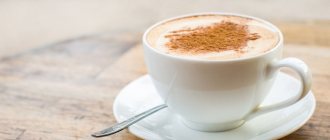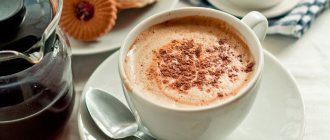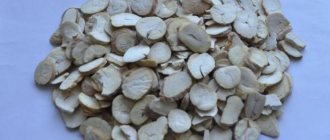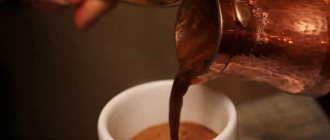Cappuccino is an Italian espresso-based coffee drink. The classic version includes a double portion of black coffee, hot milk and thick milk foam, but some baristas use cream instead of the last two ingredients, and also add cinnamon, chocolate chips, and orange zest to the drink.
Cappuccino has a mild taste with a slight coffee bitterness. If everything is done correctly, the drink should turn out sweet even without adding sugar (due to the fatty milk foamed by the cappuccino maker).
Interesting fact: despite the apparent simplicity of the recipe, making cappuccino is quite difficult. At international barista and coffee competitions, masters often compete in preparing this particular drink.
Story
The name “cappuccino” comes from the Capuchin Order, as the color of the drink resembles the beige-brown robes of the holy brothers. The very word cappucio (Latin: Caputium) is translated from Italian as “hood” - an indispensable attribute of the daily attire of the servants of the order.
Capuchin in a hood drinks cappuccino
The term “cappuccino” first appeared in Italian in 1930, but a similar drink, Kapuziner, existed in Austria back in the 18th century. Then it consisted of coffee, sugar, cream and egg yolks (although it is not known in what proportions). At that time, Italy was under Austrian rule; during the division of countries, cappuccino “changed his citizenship” to Italian.
Fresh milk began to be used instead of cream in the 20th century, when refrigerators appeared. Until the 1950s, the term “cappuccino” meant quite a variety of drinks (with milk or cream, with or without spices), but with the spread of coffee machines, the term was consolidated in its modern meaning.
Cappuccino coffee - what is it?
The tradition of adding milk to strong coffee to soften the harshness of the taste appeared around the 17th century. We do not have reliable information about who and when became the author of this innovation. But already from the end of the 18th century, coffee with milk was served in all existing coffee houses in Europe.
Cappuccino is a term of Italian origin. Translated, it means “Capuchin”, so the name is associated with the order of Capuchin monks. It was experimentally found that if a well-mixed mixture of milk and cream was added to coffee, a stable foam in the shape of a small pyramid formed on the surface. Because of its resemblance to the white pointed hoods of the Capuchin monks, the coffee was nicknamed “cappuccino.”
The appearance of devices for frothing milk into foam subsequently raised the recipe to the heights of popularity. By the middle of the 20th century, cappuccino became one of the favorite coffee drinks, and it remains so to this day.
Characteristics of cappuccino
| Suitable coffee | A blend of Arabica and Robusta medium roast (proportions may vary). 100% Arabica possible. |
| Composition and proportions | ~15 g of freshly ground coffee beans, 60-90 ml of milk (sometimes more, depending on the recipe, fat content from 3% or higher), 50-100 ml of water. |
| Coffee machine pressure | 8-10 bar. |
| Temperature of ingredients during cooking | Water temperature for espresso is 84-90 degrees, milk temperature is 60-70 degrees. |
| Cooking time | 1 – 2 minutes. |
| Volume of one serving | 150-180 ml, sometimes 360 ml (double cappuccino). |
| Strength (caffeine content) | 50-75 mg per standard serving. |
| Serving temperature | 60-63 °C. |
| Recommended Daily Value | 3-4 servings (180 ml). |
| Calorie content | 36-56 calories (depending on the fat content of the milk). Each level teaspoon of sugar adds another 16 calories to the drink. |
Attention! The figures and proportions given are arbitrary: every good barista has his own recipe, which may differ significantly from the classic one.
In the USA, skim milk is often used; other baristas, on the contrary, prefer 11% cream; there is also the half'n'half option - a mixture of cream and milk.
How much caffeine is in cappuccino
Caffeine is an essential component of all drinks based on natural coffee. Cappuccino is no exception to the rule. Its caffeine content varies from 40 to 70 mg . Cappuccino made from ground Arabica beans will be slightly less strong due to less caffeine saturation of the beans. If a mixture of Arabica and Robusta was used to prepare the drink, then such coffee contains more stimulating alkaloid, since Robusta has a higher percentage of caffeine than Arabica.
Differences between cappuccino and other types of coffee
Cappuccino coffee is very similar to a latte, but is served in smaller cups (180 ml versus 300 ml), contains less milk and more milk foam.
Macchiato (Caffe macchiato) consists only of espresso and milk without foam.
Cortado is a Spanish coffee cocktail that contains espresso and milk in proportions of 1:1 or 1:2; condensed milk is often used instead of fresh milk.
“Flat White” is a cross between a cappuccino and a latte; its characteristic feature is a very thin layer of foam, most often with a pattern.
What is the difference between a latte and a cappuccino?
The similarity of the ingredients - milk and espresso, often leads to the fact that latte coffee is confused with cappuccino, although these are two completely different drinks. The main difference is the proportion of the basic components:
- Cappuccino – 1/3 milk foam, 1/3 milk, 1/3 espresso.
- Latte – 1/4 whipped foam, 1/4 strong coffee, 1/2 warmed milk.
But there are other differences between these drinks. These include:
- Serving method - in a coffee shop, cappuccino will be poured into a cup with a volume of no more than 180 ml; to serve a latte, choose a tall glass glass with a capacity of up to 360 ml.
- Foam - in a properly prepared cappuccino, it has a thicker and denser consistency, without sagging even under a spoon of granulated sugar. The foam of the latte is lighter and looser.
- Flavor and aroma qualities – cappuccino is characterized by a strong taste of espresso, smoothed by tones of milk. It’s not for nothing that a latte is called a cocktail with a coffee base - it has much less strength, and the milky flavors come out stronger.
Classic cappuccino recipe
Traditional proportions of coffee, milk and foam are 1:1:1.
Modern cappuccino is prepared in a coffee machine. First, a double portion of espresso is poured into a coffee glass, then the same amount of hot milk is added, and the composition is crowned with a lush head of milk foam. Another option is also common: the milk is not poured separately, but simply whipped up more foam, so that it not only settles on the drink in a voluminous cap, but also partially dissolves in it.
Ingredients:
- coffee (espresso) – 60 ml;
- milk – 60 ml;
- sugar - to taste.
Cooking technology
1. Pour a double shot of espresso (60 ml) into a tall coffee glass or cup with a minimum volume of 180 ml that has been preheated with steam.
2. Heat the milk to 60-70 °C, then beat it with a cappuccino maker, whisk or mixer into a fine foam until the volume doubles.
3. Holding the foam with a spoon, add milk to the espresso, sweeten with sugar if desired and stir. Place foam on top.
A cappuccino maker is a thin metal tube through which steam is supplied under high pressure. Milk frothed in this way acquires a sweetish taste and a particularly delicate structure due to microscopic bubbles.
Manual electric cappuccino maker. Many coffee machines have a separate unit for frothing milk.
Alternative recipe. Kapuziner – served in old Viennese cafes, black coffee with a few drops of heavy cream, just to get the right color.
Is it possible for pregnant women and children to have cappuccino?
The milk in cappuccino leads many people to believe that the drink has no restrictions on its consumption. The milk component does not replace the presence of a significant dose of caffeine in cappuccino . Milk only softens the effect of caffeine, reducing the severity of its effects.
The caffeine contained in cappuccino can have a stimulating effect on the nervous system, which is especially vulnerable in pregnant women and children. It is better for them to refrain from drinking cappuccino, as well as all other types of coffee-containing drinks, so as not to put their health at risk.
Pregnant women and children should choose cocoa or hot chocolate instead of cappuccino.
Making cappuccino without a coffee machine at home
There are two methods:
- In the microwave. First, a glass of milk is heated in the microwave at maximum power until small bubbles appear on it (on average this takes less than a minute). It is important to ensure that the liquid does not “run away”. Then beat the hot milk with a whisk or mixer, successively transferring the foam to another cup. When about half of the milk turns into foam, brew a double portion of espresso, pour the remaining milk into it, and spread the foam on top.
- Manually. Coffee is brewed in a Turkish coffee pot or brewed in a French press, and hot milk is whisked. Then all the ingredients are added to the cup.
Cappuccino made in the microwave
Cappuccino coffee cups
Cappuccino is a voluminous drink, so 180-200 ml cups are suitable for serving it. You can take larger containers, but the peculiarity of serving cappuccino is that the milk foam should not only be flush with the edge of the cup, but even slightly protrude beyond its edge. Therefore, dishes should be selected based on the portion that is prepared in your kitchen.
- Preference is given to cups in the shape of an inverted dome, with an extension at the top. In such dishes, the patterns on the surface of the cappuccino are clearly visible.
- Sometimes cappuccino is served in glass glasses for Irish coffee. The height of the foam is clearly visible in them.
- The best glassware for cappuccino remains ceramic cups with thick walls. In them, the drink retains its temperature longer, while in glass glasses the coffee cools down faster.
Traditional glassware for cappuccino is a white ceramic cup with a volume of 200 ml with thick walls.
Types of cappuccino
In addition to the traditional recipe, there are some other variations:
- Latte Art is a regular cappuccino drink, but with a pattern on the milk foam. Some baristas achieve such perfection in this art that they can even paint a portrait of a guest.
- Wet cappuccino (“wet” cappuccino) is a cocktail in which the ratio of coffee, milk and foam is shifted in favor of milk.
- Dry cappuccino (“dry” cappuccino) is the opposite of the previous option; this recipe contains less milk than other ingredients (there may be more or the same amount of foam).
- Iced cappuccino (cappuccino with ice) – in a blender, beat chilled black coffee and milk (1:2 ratio), ice cubes, sugar to taste. You can also add syrup and/or spices, or replace the milk with cream (partially or completely).
- Cappuccino Freddo (cold cappuccino) - prepared like a regular cappuccino, only all ingredients must be cold, including frothed milk.
- Babyccino is frothed milk without coffee (and therefore decaffeinated), often served with syrup.
Interesting facts about cappuccino
Finally, we want to tell you some interesting facts about the cappuccino drink:
- As you already know, coffee was prohibited, so the abbot of the monastery where the drink was drunk was summoned by the Pope himself. To avoid severe punishment, the abbot prepared a cappuccino for the Pope. My father highly appreciated the taste and aroma of this drink, so he lifted the ban on its use.
- Cappuccino keeps teeth healthy and prevents coffee pigment from leaving marks on the enamel. Therefore, you don’t have to worry about your snow-white smile.
- Italians drink cappuccino in the morning during breakfast. Drinking a drink after dinner is considered bad manners, so it is believed that only tourists can afford it.
- In 2012, the largest cup of cappuccino was prepared in Zagreb. The volume of the drink was 2 thousand liters, and 22 coffee machines were used to prepare it.
We hope you learned a lot from our article. Perhaps you also know interesting facts about your favorite drink? If yes, then tell us about them in the comments.
How to serve and drink cappuccino
In continental Europe, cappuccino is traditionally drunk in the morning, mainly at breakfast, with a croissant, white toast or other pastries. In Italy, it is even considered bad manners to drink this coffee cocktail after 11 o’clock in the afternoon and/or have something substantial, like meat or a hot dish - with all the Italians’ love for coffee, they prefer espresso after lunch.
Americans drink cappuccino throughout the day and are not averse to finishing off a hearty meal with it.
As already mentioned, a classic cappuccino is served in a preheated coffee glass or porcelain cup with a volume of 150-180 ml, but in fast foods and coffee shops like Starbucks there are portions up to 600 ml in volume.
Portrait on a cup of cappuccino, it’s even a pity to drink this
Drinking cappuccino
The Italians who created this drink consider it as a separate dish and believe that it should be drunk no later than 11 am. In addition, you should not drink the drink after a meal, because... this can have a detrimental effect on digestion.
It is believed that cappuccino should be drunk without stirring. As a result, the coffee passes through a layer of dense foam. To prevent mixing of coffee and foam, some people add toppings during preparation. However, this option is only suitable for those with a sweet tooth, because... They are very sweet on their own.
Some people prefer to skim off the foam with a spoon and then drink the coffee. This use of the drink is considered not entirely correct, because... this does not allow you to feel the full aroma of the drink.
Avid coffee lovers consider it unacceptable to add any sweeteners to this type of coffee, since, for example, sugar worsens the taste of the drink. In addition, milk and foam help reduce the bitterness of coffee.
Thus, cappuccino is an excellent drink with a coffee and milk taste.
It has medium calorie content and strength. In addition, caffeine here is partially neutralized by the milk present in the cappuccino. (to open the link from the turbo page you need to go to the full version)
Manufacturing conditions
In order to properly prepare cappuccino in a coffee machine, you should pay attention to some subtleties. The most important thing is: the choice of a dairy product and the correct selection of dishes in which coffee will be served. The easiest way to make the drink is in a coffee machine with an automatic cappuccino maker.
Characteristics of milk for cappuccino
There are some requirements for this ingredient:
- Fat content. If you use a low-fat product, a milk cap will not form. Fat content must be at least 3.5%.
- The composition of the protein, which determines how dense and soft the foam will be. The required consistency is obtained with a protein content of about 2.8-3.5. Only high-protein milk will create a cap of large, dry bubbles that create visible airiness.
- Initial temperature. The milk must be cold (3-5° C). The temperature of the whipped product should not exceed 75°, otherwise the taste of boiled milk will appear.
You cannot use low-protein, expired milk or dry powdered product to make a coffee drink.
Dishes
To make a real cappuccino, you need to choose the right glassware. Before cooking you need to pay attention to the following points:
- The dishes should be heated to approximately 40°C;
- The appearance of moisture on the container and in the pitcher is unacceptable;
- To serve, use transparent glass or ceramic cups and glasses.
Correct use of the cappuccino maker
The procedure for preparing a coffee drink in a coffee machine depends on the model of the cappuccino maker. With automatic mode, just place the container with milk in the unit and select the correct mode. The foam will flow into the espresso container on its own.
Be sure to read: Recipe for warming and piquant coffee with cognac
Making cappuccino in a simple coffee machine is a little more complicated, since it uses a manual cappuccino maker.
- The unit should be preheated for 30 minutes, releasing steam from the steam wand in advance.
- Pour milk into the bowl, the volume of which should reach below the spout, as it will increase when whipped.
- The tip of the cappuccino maker must be lowered to the bottom of the container.
- Turn on the steam and very slowly lift the tip up.
- The process is continued until milk foam appears.











